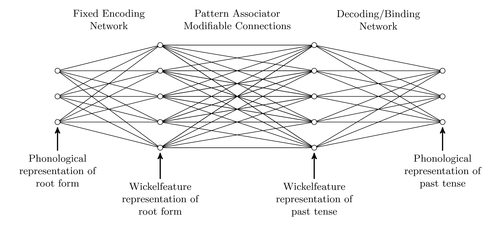A neural network example recreated from an illustration in [1].
Note the use of a background layer to draw the lines connecting the nodes. This way we don't have to worry about overlapping lines.
| [1] | Rumelhart, D. E. and McClelland, J. L. (1986). On Learning the Past Tenses of English Verbs. In Volume 2 of Rumelhart, McClelland, and the PDP Research Group (1986), pp. 216-271. |

Edit and compile if you like:
% Author: Robert Felty
% Source: http://blog.robfelty.com/2007/02/14/pgf-gallery
% Model structure from Rumelhart \& McClelland (1986, p .222)%
\documentclass{article}
\usepackage{tikz}
\usetikzlibrary{arrows}
\begin{document}
% Declare layers
\pgfdeclarelayer{background}
\pgfsetlayers{background,main}
% Styles
\tikzstyle{information text}=[text badly centered,font=\small,text width=3cm]
\begin{tikzpicture}[scale=.8,cap=round]
% The graphic
\begin{scope}[>=stealth', line width=1pt]
\draw[->] (1,.9) node[below, information text]
{Phonological representation of root form } -- (1,1.8);
\draw[->] (5,-.2) node[below,information text]
{Wickelfeature representation of root form } -- (5,.8);
\draw[->] (11,-.2) node[below,information text]
{Wickelfeature representation of past tense } -- (11,.8);
\draw[->] (16,0.9) node[below,information text]
{Phonological representation of past tense } -- (16,1.8);
\end{scope}
\draw (3,6) node[information text] { Fixed Encoding Network };
\draw (8,6) node[information text, text width=4cm, ]
{ Pattern Associator Modifiable Connections };
\draw (13.5,6) node[information text] { Decoding/Binding Network };
% draw the nodes
\foreach \x in {1,16}
\foreach \y in {2,3,4} {
\filldraw[fill=white] (\x,\y) circle (0.1);
}
\foreach \x in {5,11}
\foreach \y in {1,2,3,4,5} {
\filldraw[fill=white] (\x,\y) circle (0.1);
}
% The lines connecting the nodes are drawn in the background layer.
% This way we can hide the lines behind the nodes and don't worry
% about the width of each node.
\begin{pgfonlayer}{background}
% we add the lines for the nodes starting in y 2,3, and 4
\foreach \xa / \xb in {1 / 5, 5 / 11 , 11 / 5 , 16 / 11}
\foreach \ya / \yb / \yc / \yd / \ye in {2 / 3 / 4 / 5 / 1,
3 / 4 / 5 / 1 / 2, 4 / 5 / 1 / 2 / 3} {
\draw (\xa,\ya) -- (\xb,\ya);
\draw (\xa,\ya) -- (\xb,\yb);
\draw (\xa,\ya) -- (\xb,\yc);
\draw (\xa,\ya) -- (\xb,\yd);
\draw (\xa,\ya) -- (\xb,\ye);
}
% add remaining lines from y1 to y5
\foreach \xa / \xb in {5 / 11 , 11 / 5}
\foreach \ya / \yb in {1 / 5, 5 / 1} {
\draw (\xa,\ya) -- (\xb,\ya);
\draw (\xa,\ya) -- (\xb,\yb);
}
\end{pgfonlayer}
\end{tikzpicture}
\end{document}Click to download: distributed-processing.tex • distributed-processing.pdf
Open in Overleaf: distributed-processing.tex


